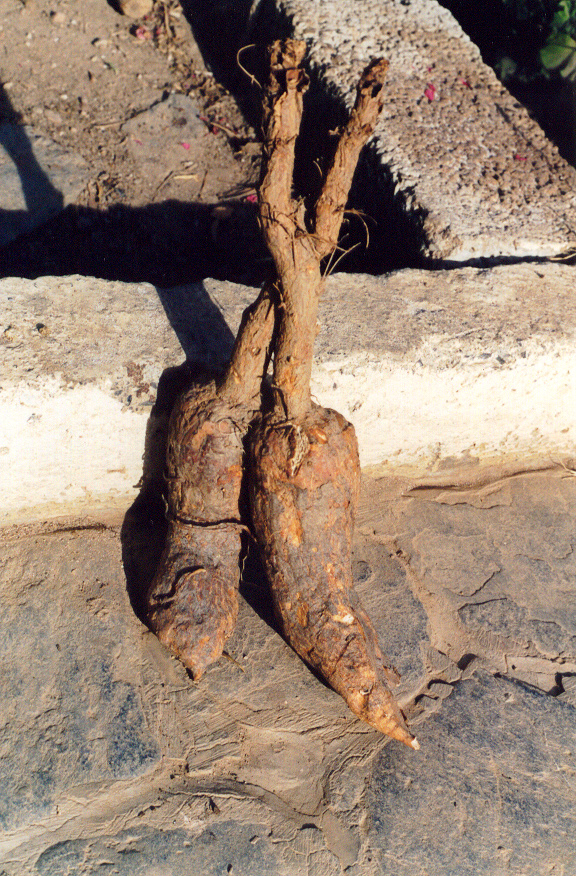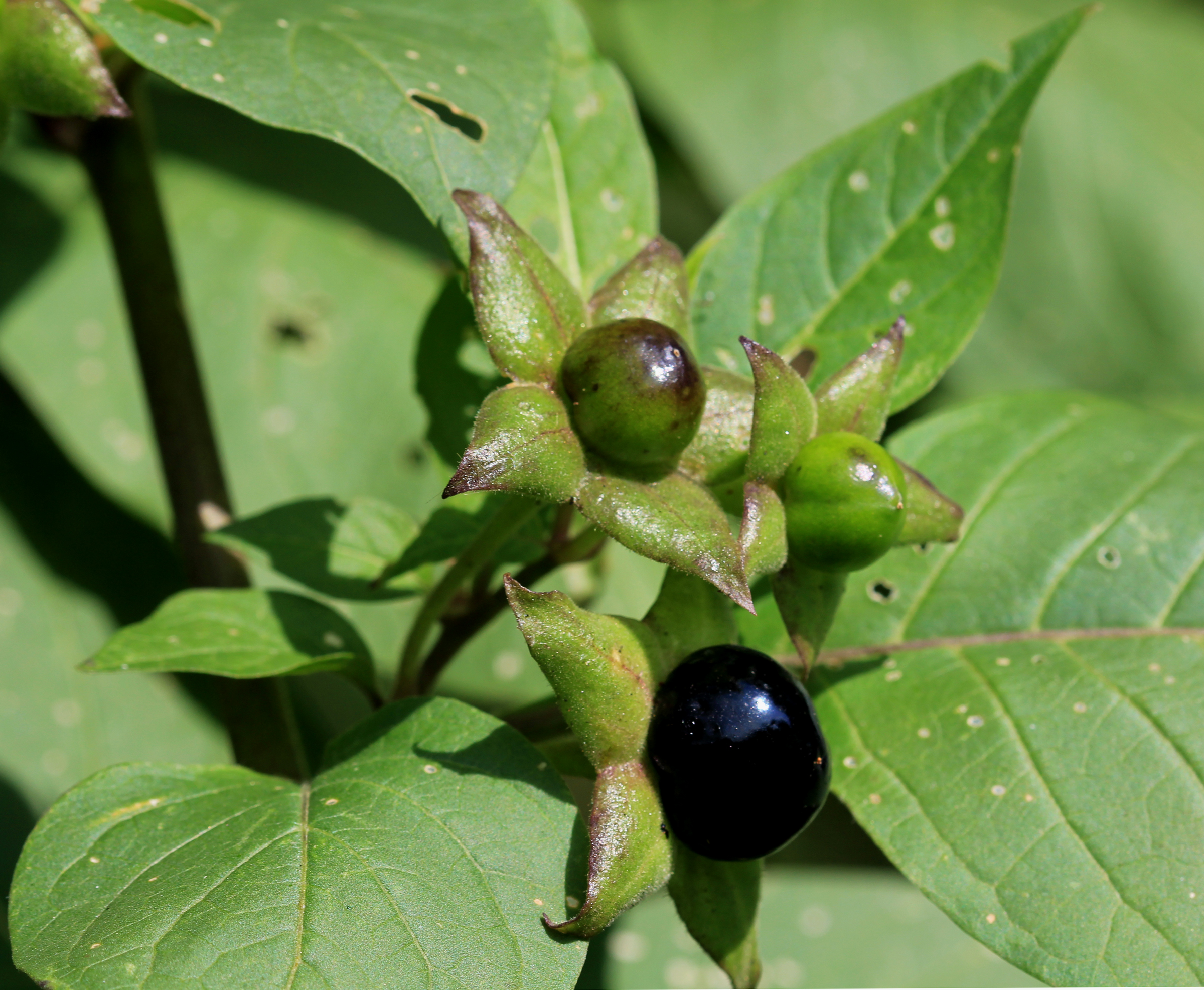Classification
Atropa belladonna,
or more commonly know as
Belladonna, Deadly Nightshade, Dwale, Devil's Berries, or Death
Cherries, received this name from one of the Greek goddesses of
fate, Atropos, who is said to have cut the thread of life from
the poison of the berries of this herb. The second part of the
name, belladonna, comes from the Italian word
 meaning
beautiful lady. One explanation for why this plant was given the
name "beautiful lady" comes from the practice of Italian women
using the juices of the berries from the plant in their eyes to
dilate their pupils to make them look more beautiful and
attractive. Another explanation tells us that at one time men
believed that this herb turned into a beautiful lady at night.
For further specific classification see the list bellow.
meaning
beautiful lady. One explanation for why this plant was given the
name "beautiful lady" comes from the practice of Italian women
using the juices of the berries from the plant in their eyes to
dilate their pupils to make them look more beautiful and
attractive. Another explanation tells us that at one time men
believed that this herb turned into a beautiful lady at night.
For further specific classification see the list bellow.
Domain Eukarya: distinguished
by organisms containing eukaryotic cells. These cells are ones
that contain membrane bound organelles like mitochondria or
chloroplasts. Eukaryotic cells are also generally much larger
than Prokaryotic cells. Some more distinguishing features of
Eukaryotic cells are their multiple linear chromosomes, their multicellularity (although some Eukaryotic organisms like yeast
and protists are unicellular), cell division by mitosis, and 80S
ribosomes contained in the cells. This kingdom contains many
diverse organisms from humans to yeast to spiders as well as
plants like ferns and oak trees. The phylogenetic tree at the
right shows of eukaryotes are related to prokaryotes and
Archaea. This tree shows that all life arose from one common
ancestor.
multicellularity (although some Eukaryotic organisms like yeast
and protists are unicellular), cell division by mitosis, and 80S
ribosomes contained in the cells. This kingdom contains many
diverse organisms from humans to yeast to spiders as well as
plants like ferns and oak trees. The phylogenetic tree at the
right shows of eukaryotes are related to prokaryotes and
Archaea. This tree shows that all life arose from one common
ancestor.
Kingdom Plantae: this kingdom
contains organisms that are multicellular and have rigid cell
walls (most of which are composed of cellulose). The organisms
in this kingdom go through alternation of generations in their
reproductive cycle. This means that they spend time as
multicellular sporophytes, with ploidy 2n, and gametophytes,
with ploidy 1n. This kingdom is also characterized by being
photoautotrophic, which means that these organisms get energy
from sunlight
 (photo) and produce their own food (autotroph).
They produce this food through photosynthesis, during which they
take energy from the sun, carbon dioxide, and water and yield
sugars that the plant can then use for energy. The phylogenetic
tree at the left shows the relationship between land plants. You
can see from this tree that angiosperms (flowering plants are
most derived of the plants.
(photo) and produce their own food (autotroph).
They produce this food through photosynthesis, during which they
take energy from the sun, carbon dioxide, and water and yield
sugars that the plant can then use for energy. The phylogenetic
tree at the left shows the relationship between land plants. You
can see from this tree that angiosperms (flowering plants are
most derived of the plants.
Phylum Magnoliophyta: which is characterized by flowering plants known as angiosperms. The plants in this phylum all contain true flowers. The parts of these flowers include the sepal and petals, and the reproductive parts known as the stamen and the carpel. These plants reproduce via pollination, which can either be cross pollination with another plant or self pollination within the same plant. Double fertilization happens with all organisms in this phylum and produces the endosperm inside the seeds with feeds the growing plant until it breaks through the soil and can photosynthesize. Plants in this phylum include everything from cherry trees and woody plants to herbs like Atropa belladonna.
Class Magnoliopsida: this
class contains all Eudicots. Eudicots are characterized by the
presence of two cotyledons, which is the embryo inside of the
seed. More characteristics include netlike veins on the leaves
of the plant, presence of a taproot, ring arrangement of
vascular tissue, three openings in the pollen grain, and an
arrangement of petals on flowers occurs normally in multiples of
four or five. Some organisms in this class include rose, bean
and mustard plants.
occurs normally in multiples of
four or five. Some organisms in this class include rose, bean
and mustard plants.
Order Solanales: this is the potato order of the flowering plants. This means that these plants bear tube roots known as "potatoes". These organisms also belong to an Asterid clad. This means that they all have one common ancestor. Another name meaning organisms derived from one common ancestor is monophyletic. Some organisms in this order are bell peppers, sweet potatoes, tobacco, and tomatoes.
Family Solanaceae: this family
is also known as the nightshade family. This family contains
most herbs, shrubs and woody plants. Leaves of these plants
alternate and are often in unequal pairs and flowers of most of
these plants contain both sexes in the same flower. The flowers
of these plants are most often pollinated by insects, although
in tropical
 regions bats and birds could be the pollinators. The
fruit of these plants is a berry or capsule and contains many
seeds. These plants are also important for medicinal uses.
Some plants in this family include eggplant, mandrake, and
jimsonweed.
regions bats and birds could be the pollinators. The
fruit of these plants is a berry or capsule and contains many
seeds. These plants are also important for medicinal uses.
Some plants in this family include eggplant, mandrake, and
jimsonweed.
Genus Atropa: this genus contains African and Eurasian herbs that have entire leaves. This means that the leaves have smooth edges with no notches or indents. These plants also possess alkaloids like atropine which can be used for medical purposes but are also toxic and can be used to make various poisons. Atropa acuminata and Atropa mandrogora are some other species of the same genus.
Species Atropa belladonna: This is the specific species discussed in the top paragraph on this page. This species is shrub like and perennial. The stem is purplish in color, cylindrical and bears leaves and flowers and the plant normally grows to about 2 or 3 feet tall. The flowers are bell-shaped, contain five petals per flower and are a dull purple color. The leaves have entire edges and alternate down the stem of the plant. The leaves have a darker green color on the top and a slightly paler green color on the underside. Plant also contain large round berries that turn from a green color to a dark purple or black color when they are ripened. The entire plant contains the toxic alkaloid atropine, although it is most concentrated in the roots of the plant. This plant is found in the Eurasian part of the world.
For more information on where to find Atropa belladonna
go to the Habitat page by using this
hyperlink.
If you wish to go back to the Home Page follow the hyperlink here.